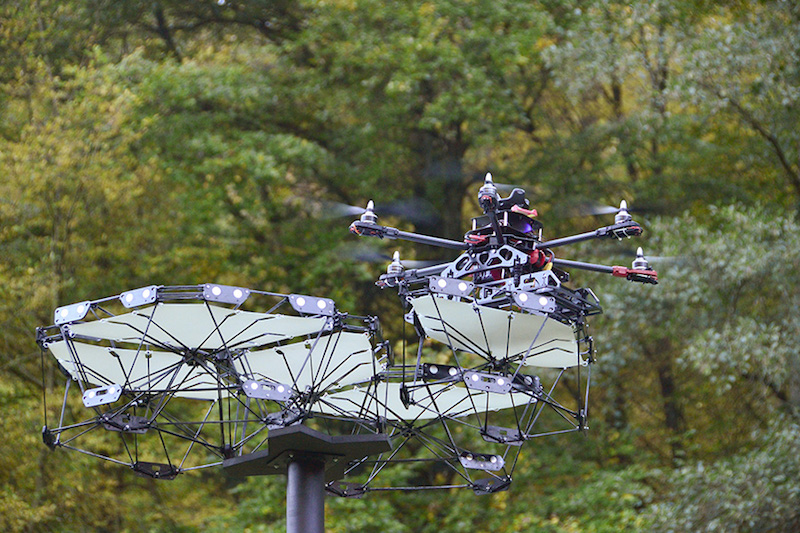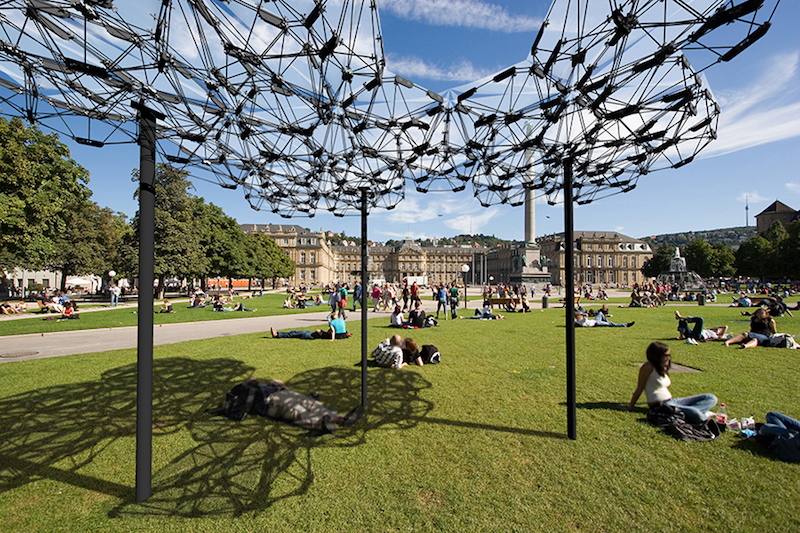Architecture is always evolving. Be it the way buildings are designed, the processes by which they are built, or the materials used. But a new prototype from the University of Stuttgart takes this continuous evolution to a new level, with a reconfigurable canopy system for public spaces that is in a state of perpetual construction.
The Cyber Physical Macro Material as a UAV [re]Configurable Architectural System (hopefully the name will continue to evolve as well) combines cyber-physical building material constructed from lightweight carbon fiber filament with integrated electronics for communication and sensing, with a collection of autonomous aerial vehicles, dubbed builders.

The canopy is composed of individual pieces that measure 40 cm wide, 64 cm long, and 25 cm tall. Each piece is composed of a roof plate that acts as the shading element, an attachment bar for UAV transport, ABS attachment plates with embedded magnets, an electronic board with a microchip, a sensor for external data input, and elements that allow each unit to communicate with every other unit.
See Also: When pigs fly? How about when cows float?
These units communicate with the UAV builders to facilitate the canopy’s movement. Separate vertical zones allow for simultaneous construction and use. This means the builders will be busy overhead changing the structure while users can still enjoy the space beneath. When the builders are not in use, they retreat to a nearby building rooftop.

This combination of distributed robotic construction and programmable matter allows for the canopy system to constantly evolve based on its surroundings. The system can be programmed with responsive behaviors, such as following the sun’s orientation to maintain a constant shadow area, or with interactive behavior, which means the user can place columns as an interface to inform the structure where to grow.
The system can also be set to probe the environment for data to develop and learn new behaviors; after time, the system will be able to predict user behavior and change to a relevant configuration in advance.
It remains to be seen if having a hive of drones buzzing overhead will spoil the experience for some users, or if the builders will be able to reconfigure the canopy quickly enough to keep up with how people would use a given green space. At the very least, the prototype is meant to challenge “preconceived ideas of robotic digital fabrication and sophisticated prefabrication for architecture.” Miguel Aflalo, Jingcheng Chen, and Behrooz Tahanzadeh created the prototype.

Related Stories
Great Solutions | Aug 23, 2016
Biophilic pods beat the shade when it comes to outdoor cooling
The Xylem concept by CallisonRTKL regulates outdoor thermal comfort through shading, air movement, water circulation, and a vegetated roof.
Great Solutions | Aug 23, 2016
Mini-grant R&D program pays off in a big way for AE firm
Created through funding from Little’s LaceUp program, the Center for Building Performance has helped the design firm win 14 new jobs since its inception.
Great Solutions | Aug 23, 2016
At Beyer Blinder Belle everyone’s seeing RED
The firm’s R&D initiative inspires its designers to develop ideas that could positively disrupt the practice.
Great Solutions | Aug 23, 2016
Virtual care facility serves remote patients, may reduce readmissions
Mercy’s new high-tech medical center equips its medical professionals to deliver care at the bedside of patients anywhere.
Great Solutions | Aug 23, 2016
11 great solutions for the commercial construction market
A roll-up emergency department, next-gen telemedicine center, and biophilic cooling pods are among the AEC industry’s clever ideas and novel innovations for 2016.
Great Solutions | Jan 20, 2016
13 great solutions for commercial construction
As these 13 innovations for the AEC marketplace demonstrate, sometimes a problem can be a good thing.
Great Solutions | Jan 20, 2016
Digitally fabricated concrete formwork pushes the limits of what can be cost-effectively constructed in concrete
Simpson Gumpertz & Heger and CW Keller use 3D modeling and CNC machining to advance concrete construction.
Great Solutions | Jan 20, 2016
Sasaki Associates develops simple yet novel solution for precast concrete complication
Its double-angle cladding anchor maintains the air/water/vapor barrier integrity and continuous insulation while still allowing for the desired versatility of precast panels.
Great Solutions | Jan 20, 2016
Porcelanosa’s solid-surface product, Krion, used to create an elegant retractable ceiling for NY showroom
Typically used for countertops, vanities, and furniture, Krion was used to make 39 panels covering 1,300 sf of ceiling space above the showroom.
Great Solutions | Jan 20, 2016
Skanska’s new app helps construction teams monitor and meet environmental quality standards while renovating hospitals
App allows users to track noise, differential pressure levels, vibration, and dust

















